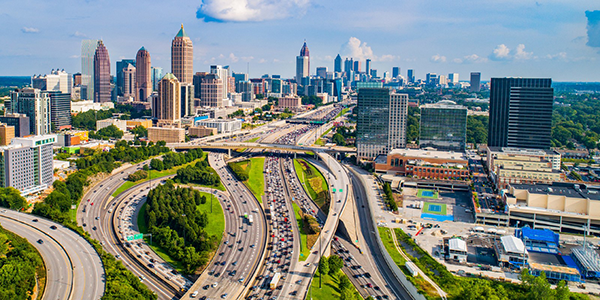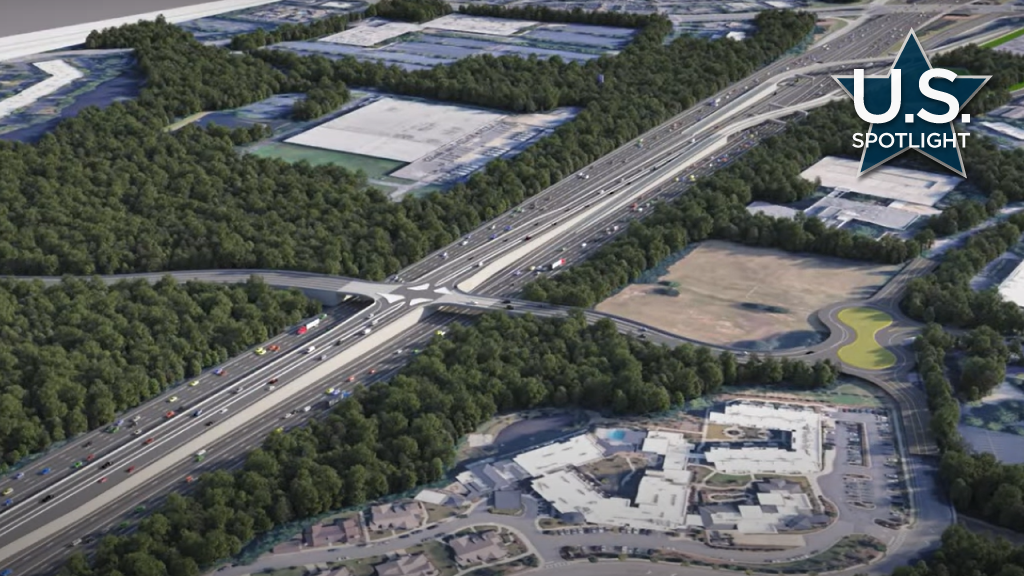Designs are being completed for a $4.6-billion project that entails building and managing 25 kilometres of new tolled express lanes and a bus rapid transit (BRT) line along the busy SR 400 in Atlanta.
The roadway is the primary north-south link between Atlanta’s major business districts and residential areas to the north in Fulton and Forsyth counties. It is one of the largest highway projects in the U.S.
The Georgia Department of Transportation (GDOT) is still buying up land for the right of way for the highway. Meantime, builders are working on environmental re-evaluations and financing.
Construction is expected to start later this year. The project will take about six years to build, with substantial completion anticipated in 2031.
A consortium known as SR400 Peach Partners has been awarded the contract to finance, build and then operate the lanes for 50 years. The consortium consists of ACS Infra Group, Acciona Concesiones and Meridiam. Dragados and Acciona Construcción are the builders. Parsons is the designer.
“Our team is proud to have been selected as long-term partners to GDOT, the State Road and Tollway Authority (SRTA) and key project stakeholders in this transformative project,” says Meridiam Americas CEO Nicolas Rubio.

We are fully committed to bringing reliable, safe travel and improved mobility to the Atlanta community and broader region for generations to come and will deploy the operational expertise and on-time, on-budget delivery reflected in our longstanding U.S. track record.”
Two managed express lanes will be built in each direction on each side of the existing roadway between North Springs Station and north of McFarland Parkway, as well as an additional managed lane in some additional segments of the project. Another 1.5-kilometre-long express lane will be built in each direction from McGinnis Ferry Road to McFarland Parkway.
Several bridges along the road will also be refurbished, including Pitts Road, Roberts Drive and Kimball Bridge.
The new lanes will have variable-priced tolls that offer a choice for drivers to bypass congestion and enjoy a reliable trip and improved mobility options.
The consortium plans to use a dynamic toll system for the express lanes that will help improve traffic flow. It is a pioneering system whereby the amount to be paid by the driver varies according to the volume of traffic on the highway, allowing vehicles to access additional toll lanes and thus reducing traffic jams and polluting emissions.
Once completed, motorists will have access to the express lanes at multiple access points along the corridor.
The BRT line, meanwhile, will begin at the North Springs Metropolitan Atlanta Rapid Transit Authority (MARTA) Station and extend northward to the Windward Parkway Park and Ride. It will provide a connection to other MARTA lines.
The private sector partner will be responsible for building significant portions of two BRT stations at Holcomb Bridge Road and at North Point Mall area and direct access to North Springs station and Windward Parkway. SR 400 Peach Partners will provide $26 million to support the build out.
Construction is being scheduled to minimize disruption to existing traffic, using innovative technology based on the use of traffic forecast models combined with radar technology. The consortium will also carry out reduction and regeneration measures for environmental and social impact, with the latter focusing on initiatives to promote local businesses and entrepreneurship.
In a statement, Meridiam noted the project is focused on improving public accessibility and fostering local economic growth and the new lanes will provide a faster and safer travel option.
“Construction has been carefully planned to minimize disruptions by co-ordinating work during off-peak hours and utilizing phased construction methods. This approach will help ensure that the majority of traffic lanes remain open throughout the process.”
The express lanes are being built to keep up with population growth in Atlanta, which is the third fastest growing metropolis in the U.S. and home to one of the world’s busiest airports. Further growth is expected for the corridor, with 144,000 more residents and 114,000 more jobs projected by 2050.
The additional lanes are a critical piece of Georgia’s Major Mobility Investment Program that seeks to improve roadway connections and reduce congestion on both SR 400 itself and its connection to I-285.
The venture is being financed with a combination of equity and debt that will include a loan from the U.S. Department of Transportation and funds from taxable and tax-exempt bonds that will be issued.
GDOT started a new P3 procurement process in 2022. For the SR 400 project, the approach reduces the public funding needed since the private sector partner will finance the entire project.




Recent Comments